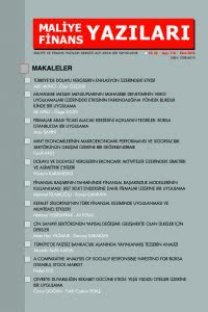Türk Bankacılık Sektöründe Piyasa Yoğunlaşması: 2001 Krizi Öncesi ve Sonrasının Karşılaştırılması
Piyasa
yoğunlaşma endeksleri çeşitli sektörlerde rekabet düzeylerini ve piyasaya
giriş-çıkış serbestilerini ölçmek için kullanılmaktadır. Bu çalışmada da 2001
krizi öncesi ve sonrası için Türk Bankacılık Sektörüne ait veriler kullanılarak
yoğunlaşma düzeyi hesaplanan endeksler yardımıyla ortaya konulması
amaçlanmıştır. Sektörde kriz öncesi - kriz sonrası yoğunlaşma oranlarından aktif,
mevduat, kar, kredi, özkaynak büyüklükleri için anlamlı farklılık bulunmuş, 2001
krizi sonrasında sektör yoğunlaşma değerlerinin bu kriterlerde yükseldiği
gözlenmiştir. Şube ve personel sayısı açısından anlamlı bir farklılığa
rastlanmamıştır.
Anahtar Kelimeler:
piyasa yoğunlaşması, yoğunlaşma endeksleri, Türk Bankacılık Sektörü, 2001 Krizi
Market Concentration inTurkish Banking Sector: Before and After 2001 Crisis Comparison
Concentration
indices are usually used for calculating competition levels and assessing
market entry-exit conditions in various industries. Likewise in this study we
aim to reveal the market concentration levels in Turkish Banking Sector for
post and pre 2001 crisis periods by using concentration indices. Also to be
able to make pre and post crisis comparisons t-tests are conducted. It was found
that there are significant differences in market concentration levels when pre
and post 2001 crisis comparisons are made. Moreover as consistent with our
expectations both in terms of assets, deposits, revenues, loans, equity
capital, branch and employee numbers an increase in market concentration ratios
for post-2001 crisis period is observed.
___
- Bikker, J.A., Haaf, K. 2000. “Competition, Concentration and Their Relationship: An Emprical Analysis of The Banking Industry”, Research Series Supervision No. 30 De Nederlandsche Bank. Bikker, J.A., Haaf, K. 2002. “Concentration in The Banking Indıstry: A Review of The Literature”, Economic and Financial Modelling, 9(2), 53-98. Bikker, J.A., Spierdijk, L. 2008. “How Banking Competition Changed Over Time”, Utrecht School of Economics, Tjalling C. Koopmans Research Institute, Discussion Paper Series 08-04. Hall, M., Tideman, N. 1967. “Measures of Concentration”, American Statistical Association Journal, 62, 162-168. Hannah, L., Kay, J.A. 1977. Concentration in Modern Industry, MacMillan: London. Hause, J.C. 1977. “The Measurement of Concentrated Industrial Structure and The Size Distrubution of Firms”, Annals of Economic and Social Measurement, 6, 73-107. Herfindahl, O.C. 1959. Copper Costs and Prices: 1870 – 1957. Baltimore: The John Hopkins Press. Hirschman, A.O. 1964. “The Paternity of an Index”, American Economic Review, 54, 761-762. Horvart, J. 1970. “Suggestion for A Comprehensive Measure of Concentration”, Southern Economic Journal, 36, 446-452. Khan, S.J.M. 2014. “Concentration in Southeast Asia Banking”, American Journal of Economics, 2014; 4(3): 150-158. Kumar, P., Bishnoi, N.K. ve Chauhan, P. 2015. “Bank Market Strucuture and Concentration in Indian Banking Sector”, The Journal of Institute of Public Enterprise, 38 (1-2), 103-127. Memic, D. 2015. “Banking Competition and Eficiency: Empirical Analysis on Bosnia and Herzegovinia Using Panzar – Rosse Model”, Business Systems Research, 6(1), 72-92. Rosenbluth, G. 1955. “Measures of Concentration”, Business Concentration and Price Policy, NBER, 57-99. Shahiki Tash, M.N., Pahlavani, M. ve Barghandan, K.2015. “Evaluating The Relationship Between Concentration Indicators and Profitability of Banking Industry in Iran”, Çankara Karatekin Üniversitesi İİBF Dergisi, 5(2), 495-505. Rinkeviciüte, V., Martinkute – Kauliene, R. 2014. “Impact of Market Concentration on The Profitabilityof Lithuanian Banking Sector”, Verslas: Teorija Ir Praktika, 15(3), 254-260. Tushaj, A. 2010. “Market Concentration in The Banking Sector: Evidence from Albania”, BERG Working Paper Series No. 73. Yayla, M. 2007. “Türk Bankacılık Sektöründe Yoğunlaşma ve Rekabet: 1995-2005”, Bankacılık ve Finansal Piyasalar, 1(1), 35-61. www.tbb.org.tr
- ISSN: 1308-6014
- Yayın Aralığı: Yılda 2 Sayı
- Başlangıç: 2008
- Yayıncı: Maliye ve Finans Yazıları Yayıncılık Ltd. Şti.
Sayıdaki Diğer Makaleler
Türk Tahvillerinin CDS Primlerini Etkileyen İçsel Faktörlerin Analizi
Bankacılık Sektöründe Artan Etik İhlaller
Bütçe Hakkının Kullanılması Bakımından TBMM’nin Bütçe Sürecindeki Rolünün Değerlendirilmesi
BİST Altın Endeksi Oynaklığı Analizi ve Performans Ölçümü
Türk Bankacılık Sektöründe Piyasa Yoğunlaşması: 2001 Krizi Öncesi ve Sonrasının Karşılaştırılması
Adalet HAZAR, Onur SUNAL, Şenol BABUŞÇU, Özge SEZGİN ALP
Uluslararası Kıymetli Metal Piyasalarının Rejim Dinamikleri
Ayben KOY, Güldenur ÇETİN, İhsan ERSAN
Kurumsal Yönetim Algısı İle Kurumsal Yönetim Notu Arasındaki İlişkinin Analizi
